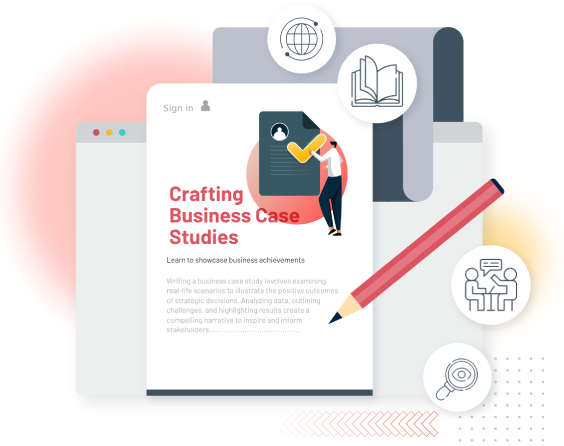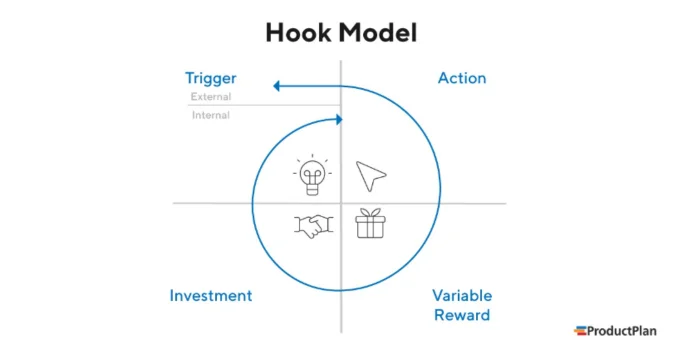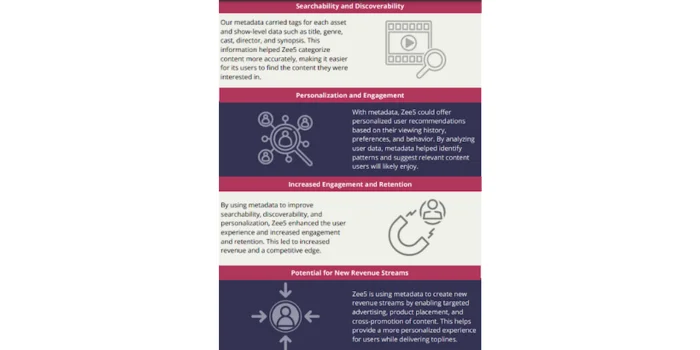
Nothing speaks louder than real results and authentic success stories. When you can show potential clients exactly how you’ve helped others grow, it creates an instant connection that numbers alone can’t match - and that’s exactly what powerful case studies deliver.
However, a case study stating the obvious isn’t enough to engage seasoned marketing professionals. To stand out, a case study needs to go beyond the primary narrative and provide compelling insights into the solutions that made a difference. These elements will ensure your case study isn’t just informative but persuasive.
If done right, your case study can be a powerful marketing tool. This post covers five crucial elements that make a case study compelling, highlighting product video services, measurable outcomes, storytelling, and more. Learn how to create engaging, result-oriented case studies that draw in new clients.

When it comes to case studies, you only have a few seconds to capture attention. A well-crafted hook piques interest and sets the tone for the rest of the study. Avoid leading with dull facts and open with an impactful statement or intriguing scenario your target audience can immediately relate to.

Marketing professionals skim through content, and your case study will likely be dismissed if the first few sentences don’t engage them. A hook positions your case study as relevant, timely, and focused on real-world problems.
For example, consider a case study for product video services where the hook goes: "The client’s conversion rates were stagnant despite continuous investment in static marketing assets. Enter Lexiconn’s dynamic product video services, which turned their results around in just two months." This grabs attention and immediately shows potential clients what’s in it. It frames the study with real-world solutions, making the reader want to learn more.
Here’s how to craft your hook:
Once your hook is solid, the rest of the study will flow naturally.
Marketing professionals want numbers in today’s age. A successful case study needs to provide measurable, tangible outcomes. This could be anything from increased conversion rates to reduced customer acquisition costs. Without concrete data, your case study risks being perceived as fluff.
To lend credibility, focus on specifics. Here’s an example: instead of saying, "Our video services helped increase engagement," a more compelling statement would be, "Our product video services led to a 35% increase in engagement across social platforms within six weeks."
The statistics speak for themselves, making it easier for your audience to visualize the impact. Furthermore, these numbers can serve as benchmarks for potential clients assessing the possible ROI of similar services.
Incorporating real-world numbers makes your case study stand out and delivers a sense of accountability.
Case Study Block Example
The client saw these measurable results due to Lexiconn’s custom product videos tailored to their audience. By providing clear data, we set up an undeniable success story that makes prospects think, “I want those kinds of results too.”
Your business success is unique and deserves to be shared with the right audience. At Lexiconn, we convert your achievements into compelling case studies that resonate with potential clients.
Schedule a 30-minute chat to turn your success into a powerful marketing tool.
A successful case study must highlight the client’s journey, not your own. The purpose is to showcase how your solution helped them overcome a specific problem.
In customer-centric storytelling, the client becomes the hero, and you are the guide. Many companies make the mistake of turning their case studies into a company-centric sales pitch. Avoid that at all costs.

You want your potential clients to relate to the challenges your case study subject faces. If they can see themselves in the narrative, they’re more likely to trust your solutions. Structure the narrative to walk the reader through the client’s pain points, your solution, and the positive outcomes.
For a business struggling with content visibility, your case study might start with how “ABC Company was losing ground in a competitive market, unable to get their products noticed through traditional marketing methods." Then, segue into how your product video services helped elevate their brand. After implementing a tailored video content strategy, ABC Company saw a 50% increase in organic reach and a marked improvement in product awareness.
This approach frames the case study in a relatable context, helping prospective clients envision how your services can solve their problems, too. It humanizes the brand and ensures the solution feels tangible, not abstract.
Customer-centric storytelling also makes your case study more enjoyable to read. By following the client’s journey, the study becomes less about you and more about their success, precisely what potential clients seek.
The meat of your case study is the solution. However, a successful solution description should be detailed without being overwhelming. Senior marketing professionals don’t want to wade through pages of technical jargon—they want to understand what you did and how you did it quickly.
Provide enough information to demonstrate your expertise, but avoid getting lost in the weeds. For example, when discussing product video services, clearly outline what made your solution effective:
For instance, instead of a long-winded explanation like, “We created a series of videos that were specifically designed to highlight product features, focusing on user experience, and made sure that these were optimized for SEO and customer engagement,” try:
“We produced SEO-optimized product videos showcasing features from a user perspective, boosting visibility and engagement.”
This approach delivers the necessary information in a way that is easy to digest. It showcases your expertise while respecting the reader's time.
When we worked with ABC Electronics, we aimed to create visually dynamic product videos that spoke directly to their tech-savvy audience. We highlighted key features in each video, optimized for multiple platforms, including YouTube and Instagram, resulting in a significant uptick in both views and conversions.
The goal is to make it easy for decision-makers to grasp how your solution directly addressed a specific issue and why it was effective. A case study should leave no room for doubt—this is where we stepped in, and this is how we got results.
A case study filled with text can easily become monotonous. That’s where visuals and data visualizations come into play. Not only do they make the content more engaging, but they also help simplify complex information.

Here is an example of how Lexiconn conveniently broke down the information in their case study via an infographic, showcasing metadata's role in improving searchability, personalization, and revenue potential.
So, when you present key metrics using visuals, you allow your audience to grasp the message in seconds rather than minutes. For example, a simple bar graph showing increased engagement after implementing video content speaks volumes without needing lengthy explanations.
When we worked with DEF Company, they struggled with lead generation from their website. After using our product video services, they saw the following improvements:
A simple pie chart or bar graph can show these outcomes at a glance, driving home the results more effectively than text alone.

The last thing you want is for your reader to finish a compelling case study and then...do nothing. A case study should always end with a call to action, prompting the reader to take the next step, booking a consultation or getting in touch for more information.
Your CTA should not feel like an afterthought but be integrated into the conclusion in a natural way.
Example: “Intrigued by our results? Discover how Lexiconn’s product video services can elevate your brand. Visit us at www.lexiconn.in or drop us a line at [email protected].”
Additionally, offering something of value, like a free consultation or a downloadable guide, can make your CTA even more persuasive.
Example: “LexiConn offers a free 30-minute content consultation session to help you strategize your next big move. Click here to book your session now.”
Your case study has done the hard work convincing the reader that you can deliver. Don’t leave them hanging and guide them toward the next step in their decision-making process.
You can create case studies that inform and persuade by focusing on these five elements—an attention-grabbing hook, measurable outcomes, customer-centric storytelling, a clear solution, and the right visuals. They are powerful marketing tools, showcasing your ability to deliver tangible client results.
Whether offering product video services or other marketing solutions, these key components will help your case studies convert readers into clients.
Make your brand ’s success stand out with high-impact case studies. At Lexiconn, we specialize in crafting case studies that convert, focusing on real, measurable results through powerful storytelling and data-driven insights.
Need help refining your content strategy? We're here to assist! Lexiconn offers a free 30-minute content consultation to discuss how case studies and other content can drive your business forward.
Book your session now and discover how our expertise can elevate your marketing efforts. Visit us at lexiconn.in or drop us a line at [email protected]



I have read and accept the Privacy Policy
Read More